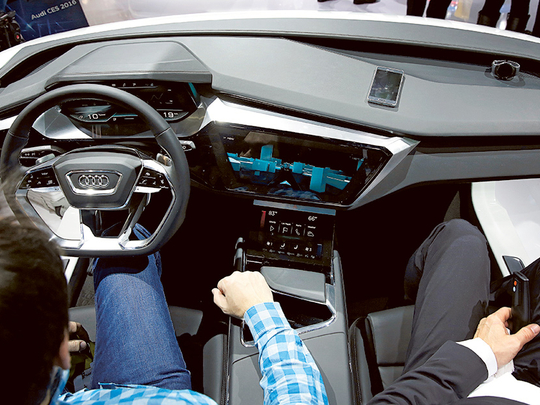
SAN FRANCISCO: Car electronics supplier Delphi Automotive Plc went coast-to-coast in 2015 in a self-driving Audi Q5 sport-utility vehicle to prove the autonomous automobile had arrived.
Now, Delphi is shifting from stunts to selling. In Las Vegas this week at CES, formerly known as the Consumer Electronics Show, the company will give test rides to hundreds of potential customers in driverless Audis over a course of rugged terrain and tunnels. The goal: to walk away from this critical conclave with a handful of hot prospects for its self-driving system.
“The last two years at CES have been more about just showcasing the technology and saying, “Look what it can do,” ‘ said Glen De Vos, Delphi’s vice president of advanced engineering. “This year, the discussion is all about the path to production.”
Self-driving cars are finally making the leap from the lab to the showroom. Tesla Motors Inc., BMW, Ford Motor Co. and Volvo Cars have all promised to have fully autonomous cars on the road within five years. Alphabet Inc. just spun off its Google Self-Driving Car Project, renaming it Waymo, and then promptly unveiled its driverless Chrysler Pacifica minivan and said it’s in discussions to put its technology into Honda Motor Co. models. When CES officially opens Jan. 5, the talk won’t be about proving technology — it will be about selling to automakers, ride-hailing companies, transit services and, ultimately, consumers.
“We’re close to bringing this to a lot of people,” John Krafcik, the former auto executive now running Waymo, said at its formation. “We’re kind of at an inflection point.”
At a show once known for mobile phones and video games, vehicle technology will cover an exhibit space the size of four football fields, some 21 per cent more than last year. Some 138 auto-tech exhibitors will all be seeking a piece of the autonomy business that Boston Consulting Group says will increase to $42 billion by 2025 and account for a quarter of global sales by 2035. And since it takes about four years to bring a car to market, now is the time to cut deals with suppliers and tech partners to outfit models with self-driving systems that will debut early next decade.
“CES 2017 marks the beginning of a new era,” said Luca Mentuccia, senior managing director and head of the automotive practice for consultant Accenture. “Autonomous driving has become the next major battlefield.”
Prius Problem
One reason for the push to get robot rides on the road is fear of the so-called Prius problem, according to Mark Wakefield, managing director and head of the automotive practice for consultant AlixPartners. The Prius became synonymous with hybrids after Toyota Motor Corp. pioneered the technology almost 20 years ago. Today, the Prius still dominates the market for gas-electric cars.
“Nobody really wants to be the competitor to the Prius, where you let one company effectively frame the experience in the buyer’s mind,” Wakefield said. “Then when you come out with one, it’s like, ‘Oh, you make one, too?” ‘
Google’s self-driving car project has garnered the most attention as it clocked more than 2 million miles of road testing over the last seven years. Waymo hasn’t yet revealed its business model, but it can draw from the success of the Android model its parent company employs in the smartphone market. Unlike traditional automakers, Alphabet’s businesses tend to focus on recurring revenue streams, such as search ads.
Google’s Project
Android, which powers four of every five smartphones sold globally, funnels money to Google services. Similarly, Waymo could build underlying software for autonomous vehicles, license it to carmakers and cash in on services and data.
“Google’s playbook here is well-tested,” said Jonathan Matus, chief executive officer of Zendrive, a transportation data start-up, who formerly worked on Android. “They understand how to use the platform to create dominance.”
Consumers will probably get their first taste of automated driving in the back seat of a robo-taxi. Uber Technologies Inc. is testing a fleet of autonomous Volvo XC90 sport-utility vehicles in Pittsburgh and Arizona. Ford, which said last week its test-fleet will triple to 90 cars this year, says its first autonomous vehicles will go to ride-hailing and ride-sharing services in 2021. General Motors Co. plans to test self-driving Chevy Bolts in Lyft ride-hailing fleets in Arizona.
Acclimating Consumers
The idea is to get consumers so comfortable with the technology that they buy it for their own car. Volvo has said it will offer its self-driving system as a $10,000 option on the XC90 in five years. GM is developing a semi-autonomous system known as Super Cruise that will allow for hands-free driving on highways.
“Chevy Bolts in a Lyft fleet will give people exposure,” Wakefield said. “As they gain confidence and think, ‘Wow, Chevy does some pretty neat stuff,’ GM is hoping that rubs off and convinces them to buy a Bolt with Super Cruise.”
It also makes business sense to put the first autonomous cars into a shared-use situation. Because the sensors that give a driverless car a 360-degree view of its surroundings are still pricey, spreading the cost over all the riders in a robot taxi will help to defray the expense.
“The high cost isn’t solved yet,” Wakefield said. “There’s not an assumption of making tons of money on this first generation or two.”
Safety Improvements
The dramatic improvements in safety that should come from semi-autonomous features such as automatic emergency braking will accelerate consumer demand for autonomy, according to Adam Jonas, an analyst with Morgan Stanley.
“It took air bags 15 years to get high penetration in cars,” Jonas said.
Palo Alto, California-based Tesla — which doesn’t exhibit at shows such as CES — may be the biggest accelerant for autonomy. Tesla is now outfitting all its cars with the hardware required to enable the robot to take the wheel. Chief Executive Officer Elon Musk says Tesla will soon be ready to flip the switch on the technology, which puts pressure on other companies to keep up. Just last week he tweeted a link to the dashboard video of a Model X whose warning chimed a moment or two before two other cars crashed ahead of it on a European highway.
“Tesla is being a disrupter,” Wakefield said. “Instead of going slow and being methodical like other automakers, they put it out there and the others have to come up with a competing product.”
Regulatory Changes
Autonomy also is getting a boost from US regulators, who in December proposed new rules that cars be embedded with chips to communicate with each other to help avoid accidents. Vehicle-to-vehicle communications, known as V2V, could arrive within five years and make driverless cars smarter and safer.
“Every government agency we work with has been waiting for this rule,” said Jim Barbaresso, national practice leader for intelligent transportation systems for consultant HNTB Corp. Now “you’re going to see more momentum in connected vehicles and more activity among automakers.”
For Delphi and its partners Mobileye NV and Intel Corp., the first application of their self-driving system could be an airport tram or a rental-lot bus. By eliminating the human driver, autonomy could cut the operating costs of such systems by 70 per cent, De Vos said.
“The economics are really compelling,” said De Vos, who will be giving tram operators test rides in Delphi’s driverless car in Las Vegas. “After CES, we expect to really be getting serious with three or four customers.”












